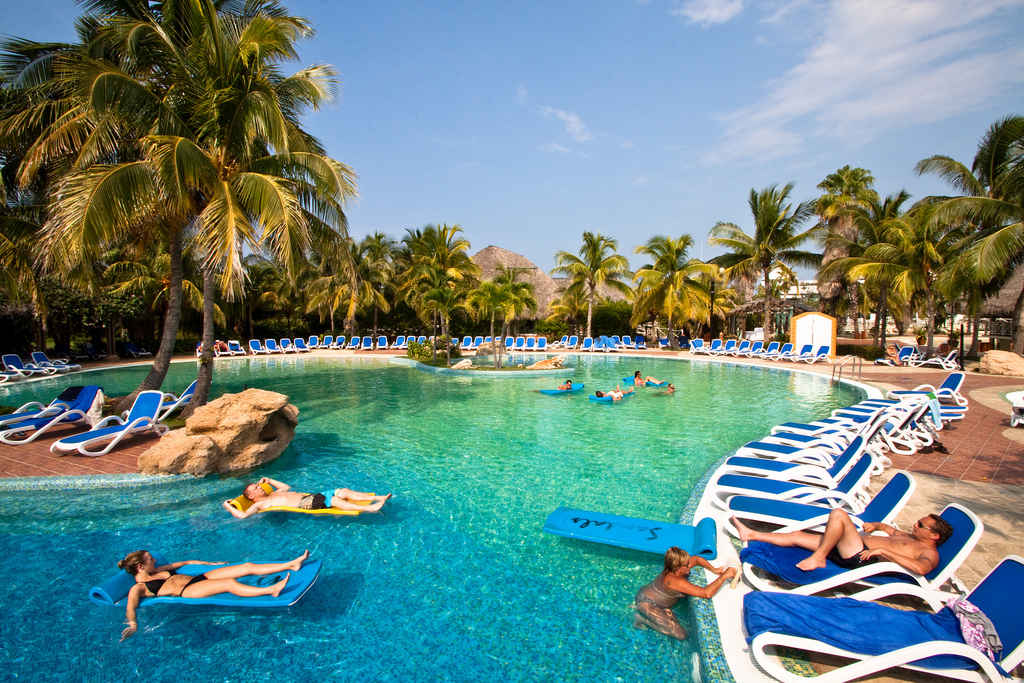Something a bit unusual for you now. A great blog post from this Chicago college about their exciting trip to one of my favourite countries, Morocco. – Ned

Thanks in part to a 2014 grant, a group of JJC faculty members recently explored the North African country of Morocco.
Tamara Brattoli (English and World Languages), Cristobal Trillo (Spanish and French), Mari Johnson (English and World Languages), Michael Hainzinger (English and World Languages) and Eva Murdoch (Natural Sciences) previewed the area ahead of eight JJC students who have signed up for the Morocco study abroad program in May. While there, they visited the cities of Tangiers, Fes, Marrakesh and Madrid, Spain.
Read on for first-hand accounts of their trip.
————————————————-
Day 1 (Mar. 12) – Arriving in Tangier
After an overnight flight with two connections, the first in Philadelphia/New York City, and the second in Madrid, Spain, we nine professors (5 from Joliet Junior College in Joliet, Illinois, and 4 from Parkland College in Champaign, Illinois) reached our final destination: Tangier, Morocco, at the northwest tip of Africa.
At the Tangier airport, we met our Moroccan guide, Karim, and were shuttled to the historic El Minzah (meaning “The Lookout” in Arabic) Hotel, set in the heart of Tangier. Despite opening its doors in 1930, several years before the start of the Second World War, it turns out that El Minzah had been named appropriately, as it actually was used as a lookout by Allied spies during World War II due to its panoramic views of the Strait of Gibraltar.
Tangier is a language lover’s paradise. It’s commonplace to hear Tangerines (not the fruit, but the demonym for residents of Tangier) speaking Arabic, French, Spanish, or a combination thereof in a single conversation, whereas in the United States, we are impressed if someone can even speak a second language. This is largely attributed to Tangier’s former status as an “international zone,” meaning several countries—mainly France and Spain—took turns controlling the city between 1912 and 1956, the year Morocco gained independence from France, and Tangier was returned to the rest of the country. It was during this period, however, that Tangier became a linguistic melting pot, so to speak, and we feel its effects to this day.
The group ate a late lunch at the Annajma restaurant, where we enjoyed a variety of local seafood, including shrimp, red mullet, calamari, squid, whiting, and solefish, and fresh fruits for dessert. When dining in a restaurant in the US, we are accustomed to ordering individual plates of food; in Morocco, however, food is often served “family style,” which consists of families and friends sharing large platters of food that are placed in the center of the table. The benefits are twofold: one has the chance to sample a wider variety of dishes, and equally important, there is more of an intimate and communal feeling to the meal.
We then went to the Hercules Caves, a maze of rocky caverns situated on the shores of Cape Spartel, the point at which the Mediterranean Sea meets the Atlantic Ocean. The caves are named for the Greek hero Hercules, whose wife, Tinge, is the namesake of the city of Tangier. Furthermore, the Atlas Mountains, named for Atlas, the Greek god of endurance and astronomy, form the divide between northern and southern Morocco. While most Americans have a general awareness of Greek mythology, and can recall a few of its major figures and the myths surrounding them, seeing firsthand the influence mythology has had on the nomenclature of Mediterranean-area toponyms makes one appreciate it more.
We drank traditional Moroccan mint tea—comprised of a green tea base, fresh mint leaves, and a pinch of sugar–at a café atop a hill overlooking the sun setting upon the sea before us.
To end our first day, we ate a traditional Moroccan meal at our hotel. We ate a variety of kebobs, indigenous fruits and vegetables, but to our surprise, we were serenaded by a Moroccan quartet that played traditional Moroccan music as we dined. There were belly dancers and a man who was able to do tricks while balancing a tray of candles on his head. Can’t wait to head to Chefchaouen tomorrow!
———————————————–
Day 2 (Mar. 13) – A Day in Chefchaouen
Around midday, our group arrived in the artsy mountain village of Chefchaouen, (“Look at the Peaks” in Arabic) about two hours southeast of Tangier. We were immediately struck by the beauty of the indigo and white color scheme of the entire village. Literally, just about every building is rinsed in a shade of blue, a tradition brought by Jewish refugees who had fled the Spanish Inquisition and settled in Chefchaouen in the 15th century. The Jews believed that painting the village in shades of blue would reflect the color of the sky and thus bring them closer to God.
As soon as we arrived, our group watched villagers hand washing clothes upon long stone slabs, using water that flows down from a natural mountain spring, something that in our culture seems only mythical. We proceeded to navigate the labyrinth of alleyways that comprise the village’s medina, or “old town,” that dates back to the 15th century. Within the medina, one can find a variety of shops where local artisans sell their wares, ranging from woven rugs to ceramic pottery.
We lunched at the Chez Hassan—an old mansion converted into a restaurant–where we ate more traditional Moroccan cuisine. It was there we were introduced to the tajine (perhaps the world’s oldest slow cooker) which is a large ceramic bowl with an accompanying lid, used for both cooking and serving food.
After our lovely day in Chefchaouen, we were treated to another delectable meal at the hotel, after which some of the group took a stroll through the center of Tangier so that we could observe the city street’s at night. We were fortunate to have with us JJC Spanish and French professor Cris Trillo, who spent the first eighteen years of his life in Tangier, and provided more insights about life in his native city than any travel guide ever could. Most poignant of all was a stop at the front door of Cris’s boyhood home.
Tomorrow we will go to the American School of Tangier, where our students will attend classes while they are here.
————————————————
Day 2 (Mar. 13) – The American School of Tangier
In the morning, the group arrived at the American School of Tangier (AST) where ten JJC/Parkland students will study for three weeks this coming May. Interestingly, the AST was founded in 1950 by Omar Pound, son of poet Ezra Pound, and over the years, several prominent American expatriots (e.g., William S. Burroughs, Tennessee Williams, Paul Bowles, etc.) have collaborated on projects with its student body. As we toured the school and campus, we were fortunate to see firsthand some of the institution’s rich history. In addition, we met with faculty and administrators and visited the classroom where our students will attend classes later this spring. We also met the school’s home-stay coordinator, who is responsible for arranging our students’ lodging during their stay in Tangier. Our hosts were very warm and accommodating and reassured us that the students will be in good hands while overseas.
Through a contact at the American School, we were able to arrange an afternoon visit to the American Legation of Tangier, a United States cultural center and museum, which is maintained and subsidized by the US State Department. We were given a private tour by the director who explained the history and purpose of this only overseas National Historic Landmark which shows the long history of collaboration between Morocco and the United States. The director explained how the Moroccan government was the first foreign government to recognize the independence of the United States, and how Tangier played an important role in World War II. We viewed displays showing the numerous American artists and authors who lived in Tangier including the aforementioned Paul Bowles, William S. Burroughs, Tennessee Williams, but also Marguerite McBey, Ira Cohen, Jack Kerouac and Allen Ginsberg.
That night we went through the market (or medina), where we sampled salted fava beans with a touch of cumin, and chickpeas. We also enjoyed freshly made donuts, fried up in front of us on the sidewalk, a treat which has ruined American-style donuts forever.
At the end of the evening, a few of us walked to the Grand Hotel Villa de France, where painter Henri Matisse took up residence in Room #35 for several months during two separate stays in Tangier. It was there that Matisse painted landscapes of scenes he observed from his window.
———————————————–
Day 4 (Mar. 15) – A Day in Assilah
In the morning, we set off for Asilah, a coastal village an hour southwest of Tangier. En route to Asilah, we pulled off the highway so that we could enjoy a short walk along the shore of the Atlantic Ocean. Only one of us was brave enough to wade knee-deep in the cold saltwater, but the rest of us had fun posing for pictures and collecting seashells in the cool, wet sand. On the way, the group also stopped to see a sheep auction on the side of the road.
We arrived in Asilah around noon, and many of us took our first-ever camel ride. Riding a camel is similar to riding on horseback, but the rider is higher off the ground, and the ride is bumpier, so holding on tight to the camel’s saddle is a must!
Karim, our guide, led us through the town’s medina—our third medina of the trip–where we explored numerous tiny shops and bazaars (an Arabic word we’ve adopted). It has become easier to recognize patterns in not only the types of shops found in Moroccan medinas, but also the art of bargaining prices with storeowners, a practice much more common in Morocco than the United States. Unlike the chain-store omnipresence in America, most Moroccan shops are of the mom-and-pop variety, so storeowners have more freedom in choosing their own prices and policies.
In addition, through a visit to a local art gallery, we learned that Asilah is well known for its contemporary art scene, which sprouted in the 1970s when dozens of Moroccan artists began holding summer workshops for children and painting gorgeous murals throughout the town.
We returned to the hotel later in the evening and dined again in the hotel restaurant. This time we decided to sample cuisine from the restaurant’s French menu. We ordered a large salad, which consisted of lettuce, heart of palm, tomatoes, cucumbers and olives, topped with tuna; then we each enjoyed an entrée of either grilled white fish or grilled chicken, and most importantly, of course, either crème brulee or crème caramel for dessert. Given the 40-year French control of Morocco, the French cuisine in North Africa is authentic. Following dinner, Professor Trillo led us on a walk through the city, where we saw the historic Teatro Cervantes, a theatre where several legendary performers held shows between 1913 and 1959. Unfortunately, the theatre has been closed indefinitely since 1959, due to the high costs required for renovation. Professor Trillo also couldn’t resist showing us the Spanish social club of Tangier, where his father, an immigrant from Spain, had been a member for many years, and where Cris learned to play pool as a child. Unbelievably, Cris ran into an old friend of his father’s while we were there, a man whom he hadn’t seen in 35 years, yet they remembered each other and chatted like old friends.
———————————————–
Day 5 (Mar. 16) – From Tangier to Rabat to Meknes to Fes
We left Tangier around 9 a.m. and arrived in Rabat, the capital city of Morocco, a few hours later. We drove to the site of what was supposed to be Morocco’s largest mosque, located in a huge public square at the center of Rabat. King Hassan II, for whom the mosque was built, passed away in 1999 before its completion, so all that remains today are several rows of pillars without a roof to unite them, and the mosque’s tower, currently wrapped in tarp and scaffoldings due to renovations. Located on one side of the gigantic square is a mausoleum that houses the tombs of three former kings. Our second stop was at the most luxurious and modern of the nine King’s Palaces in Morocco, and the current king, Mohammad VI’s primary residence.
Since the historic town of Meknes, one of the four former capital cities of Morocco, was on the way, we decided to make a stop there to see the King’s palace. The King’s palace is several centuries old, beautiful tile mosaics and fountains, and the tombs of former kings. Following the tour, we were escorted across the street to watch a man burn silver designs into metal jewelry in the back room of his shop.
At sundown, we finally arrived at the Palais Medina Hotel in Fes and enjoyed a buffet dinner in the hotel restaurant. Later on, we ventured up the street later and tried the local McDonald’s. And, when in Morocco, a former French colony, you have go with the Royale with cheese.
———————————————–
Day 6 (Mar. 17) – A Day in Fes
We left the Palais Medina Hotel early with both Karim, our regular guide, but also Mohammad, a native of Fes who specializes in giving tours of Fes’s daunting medina, the oldest and largest in Morocco.
On the way to the medina, we drove to a mountaintop that overlooks Fes’s sprawling medina below. Our next stop was at a ceramics factory, where we observed every stage of the ceramic-making process, beginning with clumps of newly delivered raw clay! From the moulding, to the painting, to the kiln-firing, it was a privilege to witness and appreciate such artisanry.
The medina consists of 400,000 people, 80,000 shops, 270 mosques, and most formidable for tourists, 9400 poorly marked streets and alleyways! Like other medinas, the streets are loosely arranged by craft. For example, one street has rug sellers, another has tajines and other earthware , yet another has jewelry and other types of metalworking, etc. Nonetheless, it’s very easy for tourists to get lost in the maze, so fortunately we had hired Mohammad, a guide with over forty years of experience navigating the narrow, winding alleys of the medina.
Inside the medina, we saw University of al-Qarawiyyin, which some contend is the world’s oldest, dating back to the 9th century. One thing is true: it was the first degree-awarding university. Originally founded as an institution for students furthering their studies of the Koran, the sacred book of Islam, the University is now part of Morocco’s state university system.
Our group then went to a silk and wool scarf-making factory. In addition to seeing bags upon bags of newly sheared woollen fleece, we saw how silk is extracted from the agave plant and then woven into fine handmade scarves. Our guides then demonstrated how Moroccan women tie the scarves to hide their hair and faces. This was followed by a tour of a rug-making factory. We learned about the three styles of rug-making and examined some of the most beautiful handmade area rugs we had ever seen. The last stop of the day was at a tannery, where we learned about each step in the leather-making process. We then saw the huge vats of dye that are used to color the leather and watched them drying in the sun.
———————————————–
Day 7 (Mar. 18) – En Route to Marrakech
The group met in the lobby of the Palais Medina Hotel at 9:00 in the morning, checked out of our rooms, and braced for the long van ride ahead. Marrakech is about 400 km from Fes, but with the less efficient Moroccan highway system, often impeded by hills, mountains, and the lackluster condition of the roads, the ride took much longer than a similar ride in the U.S. would have taken. After a couple hours of driving, we stopped at a roadside restaurant that happened to be hosting an international skeet-shooting tournament at a shooting range behind the restaurant. Many of us had never seen skeet-shooting done in person, so we were able to chalk up yet another new experience. After driving several more kilometers, we stopped for lunch at a diner that serves traditional Moroccan hamburgers, consisting of an English muffin-style bun, a beef patty, and a fried egg. We reached our final destination around 6:00 in the evening.
Marrakech, the fourth largest city in Morocco, is comparable to Las Vegas. While in the newer section of town, there are casinos, opulent western hotel chains, and nightclubs that serve alcohol, the older section contains Marrakech’s old medina, which borders the Jemaa el-Fnaa, the largest public square on the continent of Africa, and the most popular tourist location in the Kingdom of Morocco. Many Europeans come here for the warm weather and resorts. It was certainly a change from Fes.
After we checked into the hotel, we took a walk through the Jemaa el-Fnaa, where we watched a variety of street performers working for tips, as well as ordinary merchants selling everything from freshly squeezed orange juice to pirated DVDs. The snake charmers, men who play oboes to hypontize cobras, were the most memorable. We made our way through the square and circled a few alleys of the adjacent medina and retired for the evening.
———————————————–
Day 8 (Mar. 19) – A Day in Marrakech
We spent half of our only full day in Marrakech exploring the Jardin Majorelle, a large garden designed and maintained by the French painter Jacques Majorelle in the early 20th century. Over several decades, Majorelle planted rare varieties of trees and plants (e.g., cacti, palm trees, bamboo, coconut palms, thujas, weeping willows, carob trees, jasmine, agaves, white water lilies, etc.) to create his masterpiece. After decades of abandonment, the garden, which had fallen into disrepair, was purchased in 1980 by the famous French designer Yves Saint Laurent and Pierre Berge. The pair restored the garden and added a Berber museum, which houses a vast collection of artifacts from the ancient Berber culture. Both the stroll through the garden and the tour of the museum were wonderful.
We spent our last half-day doing as we pleased in Marrakech. Some of us chose to return to the Jemaa el-Fnaa and the surrounding medina to do some last-minute souvenier shopping. One brave member of our group even allowed a snake charmer to put a cobra around his neck! Others took a tour of La Mamounia, the most majestic hotel in the city.
Over a late dinner, we reflected on the differences between Marrakech and the other cities that we visited in Morocco: Tangier is the most reminiscent of European cities. Of course, this is attributable to its proximity to Spain, as well as its designation as an “interzone” for much of the 20th century, during which multiple cultures and languages came together to make Tangier the cosmopolitan center it is today. Meanwhile, Fes, with its sprawling medina, offers a window into traditional Moroccan culture and history before the age of European colonization. Like Tangier, Fes, and most other cities we passed through in Morocco, Marrakech has a rich history, but in the past decade, the city has quickly begun to transform into a prime destination for western tourists, with its 5-star international hotel chains, restaurants, casinos, nightclubs, and other amenities to attract them.
———————————————–
Day 9 (Mar. 20) – A Day in Madrid
We arrived in Madrid around lunch time and checked into our hotel. The goal then was simple: see as much as possible during our one day in Madrid. Some of us went to the Prado, the famous art museum that houses one of the finest art collections in the world. A couple of us went to another famous art museum, the Reina Sofia, which houses Picasso’s magnum opus—Guernica.
Some of us saw the Palacio Real (Royal Palace), the national palace of Spain. We saw many famous fountains and public squares. We took a long walk through the Parque del Buen Retiro and saw the famous Monumento al Rey Alfonso XII and the beautiful Crystal Palace, where fossils hang by strings from the ceiling. Professors Cris Trillo and Mike Hainzinger were even lucky enough to get tickets to a Real Madrid soccer game in the evening!
A few of us took a free walking tour around the Plaza de la Puerta del Sol, where the Spaniards hold their New Year’s Eve Countdown. Within the plaza is a small square section that contains the outline of a map of Spain. The legend is that if you step on it, you are destined to return to Madrid–I know I will.
———————————————–
Day 10 (Mar. 21) – Sweet Home, Chicago
We took an early morning direct flight from Madrid to Chicago and tried to take let it all sink in. We are very fortunate to have had the opportunity to experience firsthand a part of the world that to most is only accessible through books and films—namely, Casablanca. It is good to be home, and we look forward to integrating some of the knowledge we’ve acquired into our courses back home.



































































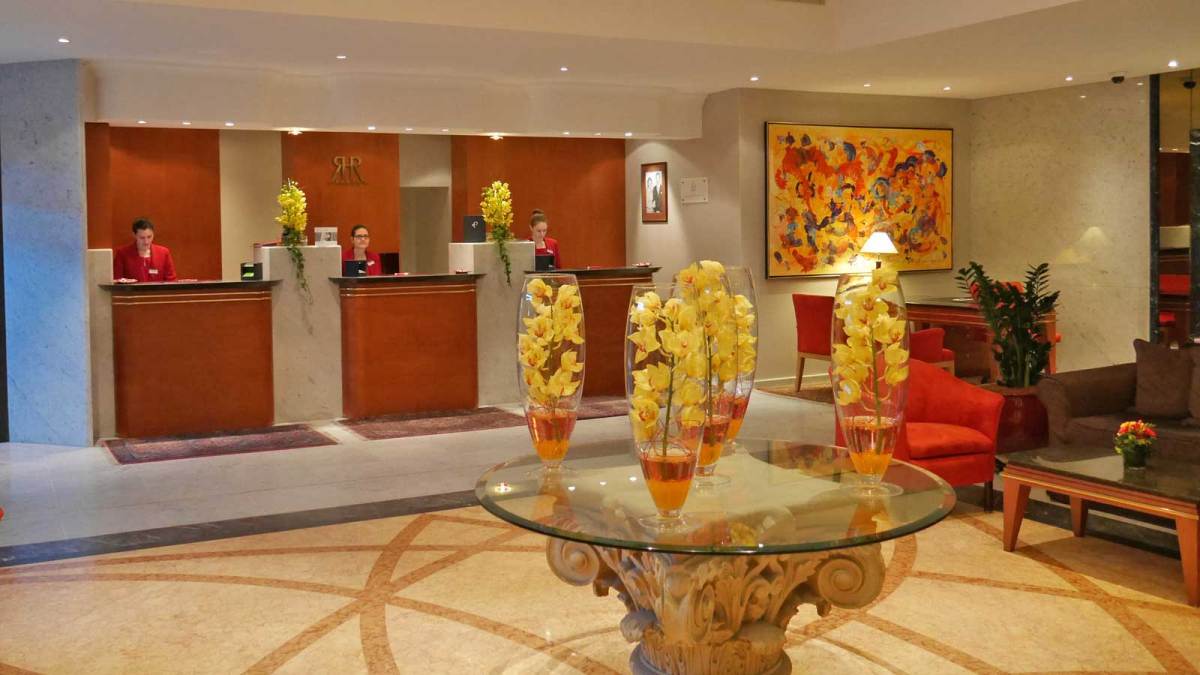








 While Jordanian cuisine is being rediscovered by Generation Y – spearheaded by new start-ups like Jordanian cookery school
While Jordanian cuisine is being rediscovered by Generation Y – spearheaded by new start-ups like Jordanian cookery school 



























































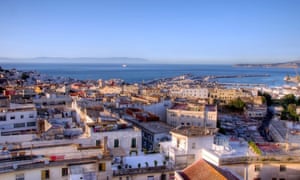
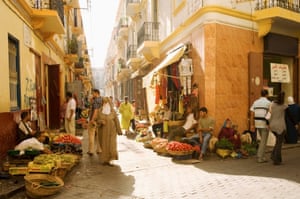




 Marrakesh is a city that is almost a 1,000 years old, so if you are wondering if there are a few historic sites to see in town, the answer is a resounding yes. Indeed, the high thick walls that surround the medina (old city) hide some real cultural gems you should make a point to see during your visit. While Moroccan architecture is a blend of many different design influences, it’s perhaps the Islamic imprint that is the most interesting. And lucky for you, all the characteristics of Islamic architecture are on display in palaces, tombs, and Koranic schools in Marrakesh. Meanwhile Marrakesh’s new city is home to some beautiful French and Islamic-inspired gardens, replete with fountains, towering shade trees and mosaic backdrops.
Marrakesh is a city that is almost a 1,000 years old, so if you are wondering if there are a few historic sites to see in town, the answer is a resounding yes. Indeed, the high thick walls that surround the medina (old city) hide some real cultural gems you should make a point to see during your visit. While Moroccan architecture is a blend of many different design influences, it’s perhaps the Islamic imprint that is the most interesting. And lucky for you, all the characteristics of Islamic architecture are on display in palaces, tombs, and Koranic schools in Marrakesh. Meanwhile Marrakesh’s new city is home to some beautiful French and Islamic-inspired gardens, replete with fountains, towering shade trees and mosaic backdrops.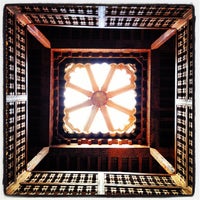 This is my very favorite building in Marrakesh. Did I mention it is a Koranic school? Yes, for more than four centuries the Ben Youssef Medersa played host to students hungry for knowledge in various subjects, including theology. The school, particularly the ground floor, is positively magnificent (and frankly, that’s an understatement). A beautiful center basin, incredible Moroccan mosaic tiled walls, hand sculpted plasterwork, and ornate wood work—all come together to enchant.
This is my very favorite building in Marrakesh. Did I mention it is a Koranic school? Yes, for more than four centuries the Ben Youssef Medersa played host to students hungry for knowledge in various subjects, including theology. The school, particularly the ground floor, is positively magnificent (and frankly, that’s an understatement). A beautiful center basin, incredible Moroccan mosaic tiled walls, hand sculpted plasterwork, and ornate wood work—all come together to enchant.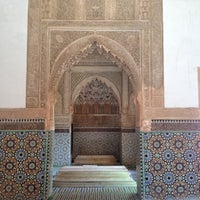 The Saadian tombs are some pretty chic burial grounds, alright. Remnants of the Saadian dynasty that used to rule Marrakesh, Sultan Ahmed al-Mansour had this series of elaborate gilded tombs made to house his remains and those of his descendants (simple coffins apparently just wouldn’t do). Unfortunately, some of the tombs are in ruins but they are nonetheless very worth visiting. Bottom line: macabre but stylish.
The Saadian tombs are some pretty chic burial grounds, alright. Remnants of the Saadian dynasty that used to rule Marrakesh, Sultan Ahmed al-Mansour had this series of elaborate gilded tombs made to house his remains and those of his descendants (simple coffins apparently just wouldn’t do). Unfortunately, some of the tombs are in ruins but they are nonetheless very worth visiting. Bottom line: macabre but stylish.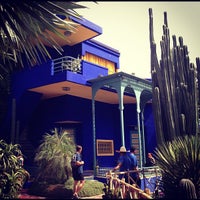 Unquestionably Marrakesh’s most fashionable (and glamorous garden), this jewel of a botanical garden in named after the French painter Jacques Majorelle who created it. The garden increased its chic-factor yet further when it was bought and restored by French fashion designer Yves Saint Laurent. There is an eye-popping variety of plants and trees from all over the world, punctuated by pergolas and fountains. The Berber museum on the Garden’s property is breathtaking—it’s where I go to take notes on Morocco’s fascinating Berber culture.
Unquestionably Marrakesh’s most fashionable (and glamorous garden), this jewel of a botanical garden in named after the French painter Jacques Majorelle who created it. The garden increased its chic-factor yet further when it was bought and restored by French fashion designer Yves Saint Laurent. There is an eye-popping variety of plants and trees from all over the world, punctuated by pergolas and fountains. The Berber museum on the Garden’s property is breathtaking—it’s where I go to take notes on Morocco’s fascinating Berber culture.
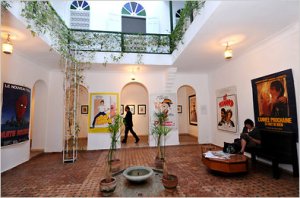 La Maison de la Photographie is one of my very favorite spots in Marrakesh. This gallery in a courtyard mansion in the old city features dozens of photos depicting Moroccan culture and history over the last 150 years or so. A documentary on Berber life by Daniel Chicault, shot 1956, runs on a loop on the second floor. The gift shop is also a great place to pick up prints and postcards. And when you are done seeing and shopping, lounge at the rooftop terrace cafe.
La Maison de la Photographie is one of my very favorite spots in Marrakesh. This gallery in a courtyard mansion in the old city features dozens of photos depicting Moroccan culture and history over the last 150 years or so. A documentary on Berber life by Daniel Chicault, shot 1956, runs on a loop on the second floor. The gift shop is also a great place to pick up prints and postcards. And when you are done seeing and shopping, lounge at the rooftop terrace cafe.





























































































































































